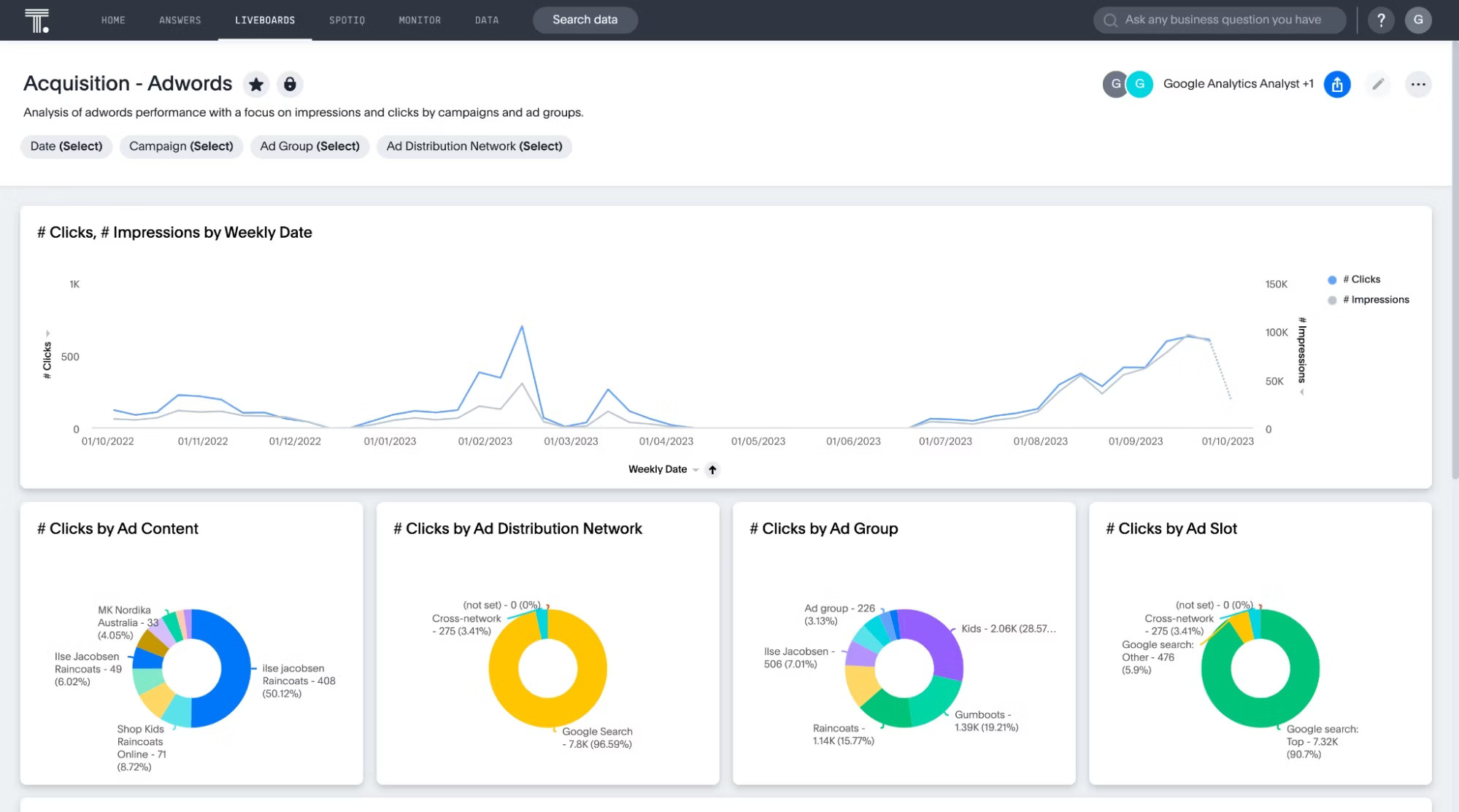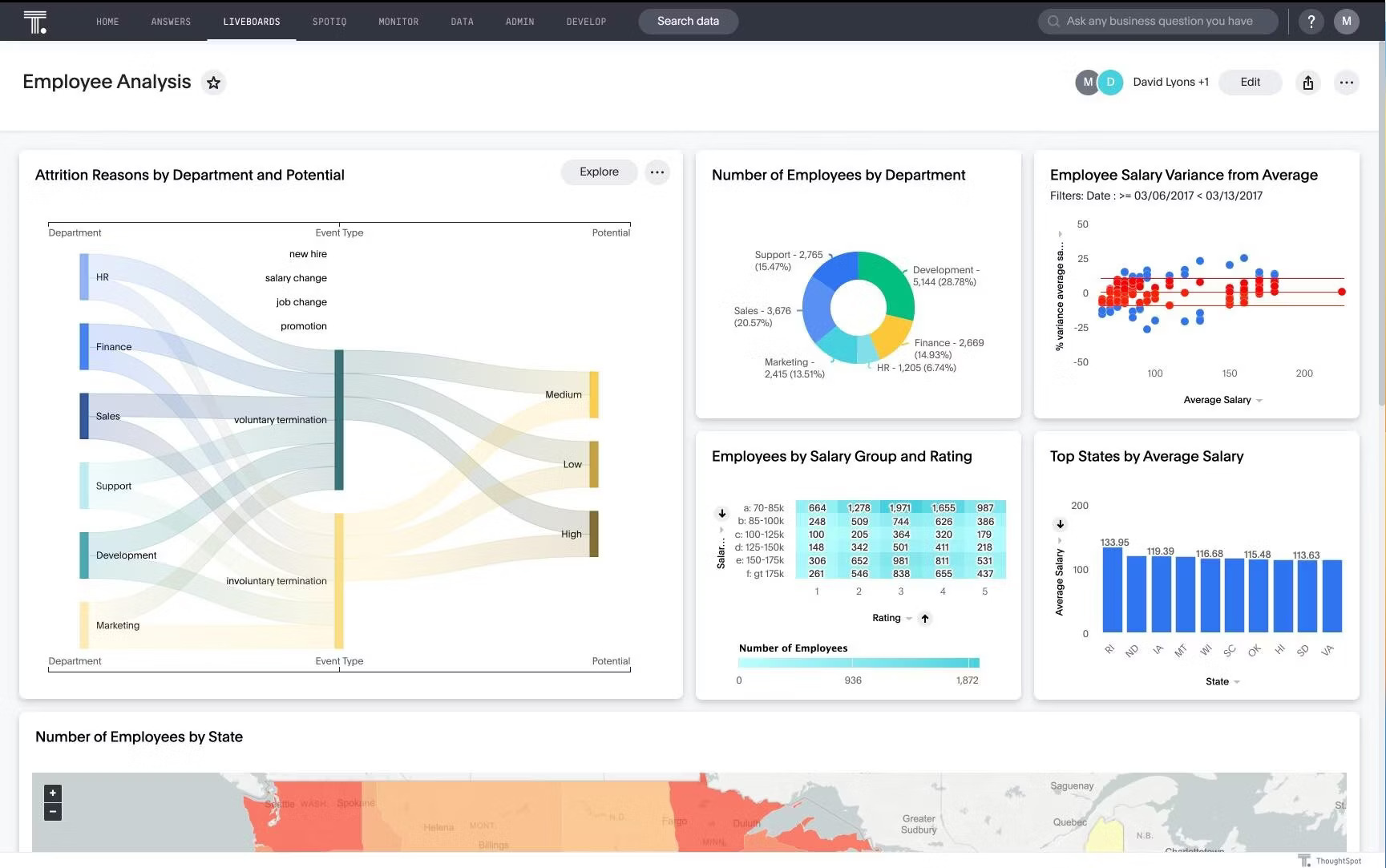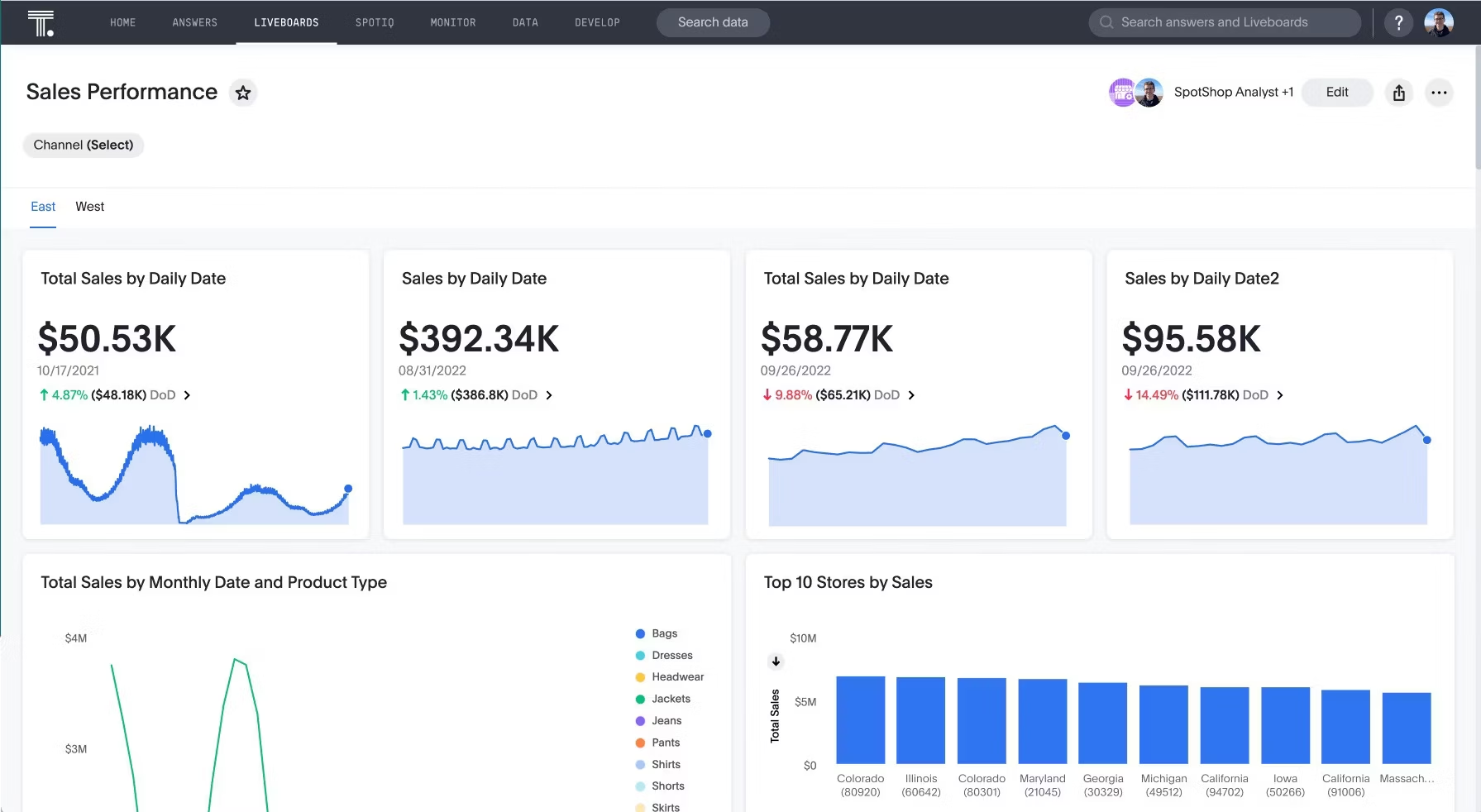Imagine if healthcare workers, pilots, or mechanical engineers operated by intuition. Without comprehensive data, where does that leave surgeries, plane landings, or building plans? Knowing the most you can about your business, people, and customers leads to positive business outcomes—no matter your industry.
Thankfully, there’s a better way to determine what customers want and need. The answer is business intelligence (BI). This process uses technology to analyze and transform data from multiple sources into actionable insights.
When set up correctly, BI tools offer a holistic, single source of truth for your company, internal teams, and individual initiatives. For more context, let’s take a look at some benefits of business intelligence that can help data leaders like you drive business outcomes:
9 benefits of business intelligence
Just knowing the definition won’t help you develop a solid understanding of the concept. Let’s review some key use cases and benefits of business intelligence:
1. Data-driven decision-making
When you have a full suite of data at your fingertips, you make better decisions. Here are a few ways departmental teams use ThoughtSpot for BI:
Marketing teams can measure campaign success, monitor real-time progress on lead generation goals, and drill into the details of A/B testing. The end result is a deeper understanding of what customers and prospects want from your company.
Product teams can analyze user engagement to prioritize feature development, understand user behaviors, and ultimately deliver stickier product experiences.
Sales leaders can pulse-check their pipeline to see how many deals are in progress, gauge conversion rates, and adjust the number of meetings booked.
Modern BI platforms help your team become a data driven business by placing the right information into the hands of frontline decision makers. It’s really as simple as that.

Consider a company like Wellthy. Before ThoughtSpot, their small yet mighty data and analytics team was pumping out every report through a slow, manual process. These reports were not insignificant—they included data points such as employee usage statistics and vital metrics demonstrating Wellthy’s value.
Just sourcing the data was a huge bottleneck, never mind getting it in front of the right people. ThoughtSpot's user-friendly search interface changed the game for Wellthy’s overburdened data team. Now, Wellthy’s leaders can visualize real-time data, dive into specific searches, and curate custom Liveboards. The results? The data team is delivering 2X the output and driving 351% in ROI.
“There's so much work that goes into data from the back end—modeling, transforming, building out dashboards, producing insights, and so on. But, if data isn’t being used to make a decision, then you're missing the most important part…”
- Kelly Burdine, Head of Data Science and Analytics, Wellthy
2. High-quality data visualizations
Data is great, but to tell a story, you need to explore it to its fullest extent. With the ability to visualize data in different ways, business leaders can discover hidden trends and patterns. Interactive data visualizations give you the power to do just that.<br><br>Unique data views help companies go further than vanity metrics. Modern BI tools like ThoughtSpot allow you to fully explore data with no predefined limitations or drill paths. This empowers users to get insights faster so they can see what’s really going on and assess gaps and opportunities.
Consider ADP, the leading payroll and HR solutions company. ADP leverages BI and embedded analytics to provide planning tools for customers’ payroll systems across a number of industries. Because of this, they need a flexible way to pick apart and visualize different data sets.
“At ADP, one of the strengths of the company is the fact that we pride ourselves in the diversity of the company itself. We offer…data in a few packages. If you're in [an] HR department, you can get it through a SaaS application…an interactive map….We [also] have fast food restaurants do[ing] demand planning. So we have all that type of information [with] lots of different distribution methods for people to consume.
- Jack Berkowitz, Chief Data Officer at ADP
3. Strong user experience (UX) for your customers
Customers crave—and expect—seamless experiences from the moment they land on your website. These expectations have only increased since the pandemic. And BI is the key to helping you deliver.
In a Product-Led Alliance report, 61% of product managers from across industries shared that embedded analytics directly resulted in increased engagement, and 57% confirmed that embedded analytics had a direct impact on revenue.
DoorDash’s VP of Analytics & Data Science, Jessica Lachs, leads the data and analytics arm of the company. She leverages BI to solve supply chain challenges and better serve their customers.
“We'll look at trends overall; we'll look at popular merchants, frequently ordered items, but it's all aggregated to understand overall marketplace dynamics, and [we] share that information with merchants on our platform so that they can improve their menus and improve their restaurant offerings.”
- Jessica Lachs, VP of Analytics & Data Science at DoorDash
This data extends across the customer experience while also creating a strong transaction model for merchants and Dashers.
4. Increased revenue
There are three primary ways your company can monetize data:
Use insights to optimize processes and reduce business costs
Enrich existing products to retain current customers and preserve market share
Create new business lines selling data products or services
Modern BI has been Northmill’s differentiator since the start. Its founders wanted to create a new type of banking experience built on intelligence, relevance and personalization. On a mission to democratize access to data and increase customer conversion rates, they turned to ThoughtSpot.
“I use ThoughtSpot to help manage the business every day, looking at metrics like sales performance across different time periods and conversion rates. It’s also a real benefit to have live data available in my phone and be able to answer questions on the spot in meetings. It certainly gives me an edge in the boardroom, in investors meetings, and so on. I can always check my phone and get the data that I want.” - Tobias Ritzé, Former CFO at Northmill Bank
Through their use of self-service BI, Northmill estimates it was able to save the equivalent of at least one full-time data analyst who would otherwise be dedicated to generating reports. They also used the insights from ThoughtSpot to boost customer conversion rates by a whopping 30%.
5. Improved efficiency
Today’s world moves at lightning speed; if companies don’t follow suit and adopt evolving technological advancements, they’ll get left behind. BI improves company efficiency helping departments work together with increased synergy to act on streamlined insights for optimal performance.
Dr. Dana Rollison, Vice President, Chief Data Officer, and Associate Center Director of Data Science at Moffitt Cancer Center, empowered the organization to harness the power of data and accelerate scientific discovery:
“The combination of those two approaches: educating so that people understand what these algorithms are doing and how they’re created, how they’re validated, as well as positioning them to really be accelerators of the physician’s day-to-day activities and not seen as a replacement, are key to the adoption of these technologies.”
- Dr. Dana Rollison, Vice President, Chief Data Officer, and Associate Center Director of Data Science at Moffitt Cancer Center
6. Strategic innovation
Combining natural language search with the power of AI, nontechnical users can start exploring their data without the help of an analyst. Self-service BI frees up your data team to focus on more strategic initiatives.
This is only the start of the AI revolution in data. Innovation is something our industry is known for. As Mastercard’s CDO, JoAnn Stonier put it:
“What's really fun about data is that it continually changes. It changes in its context. It changes its challenges, and It's changing our planet. It's endlessly innovative.”
- JoAnn Stonier, Chief Data Officer at Mastercard
In JoAnn’s own words, “the role of the CDO is to engage the business in tomorrow’s business.” This means CDOs must consistently be aligned with the company's goals, and develop capabilities that lay track for future innovation. Great data governance, data management, and data quality are table stakes. The CDO must also have a sense of where the market is going and how the business can carve out new space for itself to deliver value to customers.
7. Encourage employee success
Without top talent, a company is just an idea that lives in someone’s head. To recruit and retain the best people for any role, companies need to have their finger on the pulse of the employee experience.

Former Global Head of People Analytics at Kraft Heinz Company, Dr. Serena Huang, worked to co-create scalable solutions in predictive analytics across HR, workplace strategy, supply chain, and litigation. While Dr. Haung has since moved on from this role, her focus on data at Kraft Heinz Company empowered her to enable retention and hiring solutions that left a lasting impact on the company.
“Don’t start with data, start with the problem that you want to solve. If you have a retention problem, you want to look at your turnover data for employees. You don’t boil the ocean and try to make sure every single data element in your system is accurate, but you focus on the turnover issue at hand.”
- Dr. Serena Huang, Former Global Head of People Analytics at The Kraft Heinz Company
8. Increased competitive advantage
In the business world, speed is everything. If you are not making in-the-moment decisions, you won’t be able to respond to customer demands, improve business processes, or leverage technical advances to make data-driven decisions.
Business intelligence helps your team to spend less time on manual data cleaning and preparation, and more time on data discovery, helping you better anticipate market trends, customer behavior, and potential risks. Armed with actionable insights, you can create strategies that can help you address issues early on and stay ahead of the competition.
Here’s a real-world example of how ThoughtSpot’s AI-Powered Analytics helped Cox 2M save over $70K in data costs:
As the business grew, the company was generating 13 billion-plus new rows of data per year. But legacy BI tools made the process of data discovery incredibly slow and data costs to run ad-hoc reports were also piling up.
To tackle this challenge, Cox 2M adopted ThoughtSpot and achieved remarkable results. The company reduced time-to-insight by 76% and saved up to $70,000 in data costs. This proves how BI can infuse data into everyday decision-making to help you drive operational excellence and gain a competitive advantage.
9. Better strategic planning
Strategic planning is the backbone of any business. Yet, Gartner research shows that only 29% of strategists say their organizations change plans fast enough to respond to disruption. One of the most significant benefits of business intelligence is that it allows users to find valuable insights even from large datasets, enabling them to identify new growth opportunities and even predict future trends. For instance, sales executives monitor business performance, optimize strategies, and highlight potential deads through real-time sales KPIs and interactive dashboards.

Leverage BI with ThoughtSpot
By empowering everyone in your business to leverage modern BI solutions, data leaders can create a culture of awareness, scalability, and innovation. ThoughtSpot’s AI-Powered Analytics is the BI tool that will help you deliver that modern data experience. Sign up for your free 14-day trial today to experience the benefits of BI in action.









